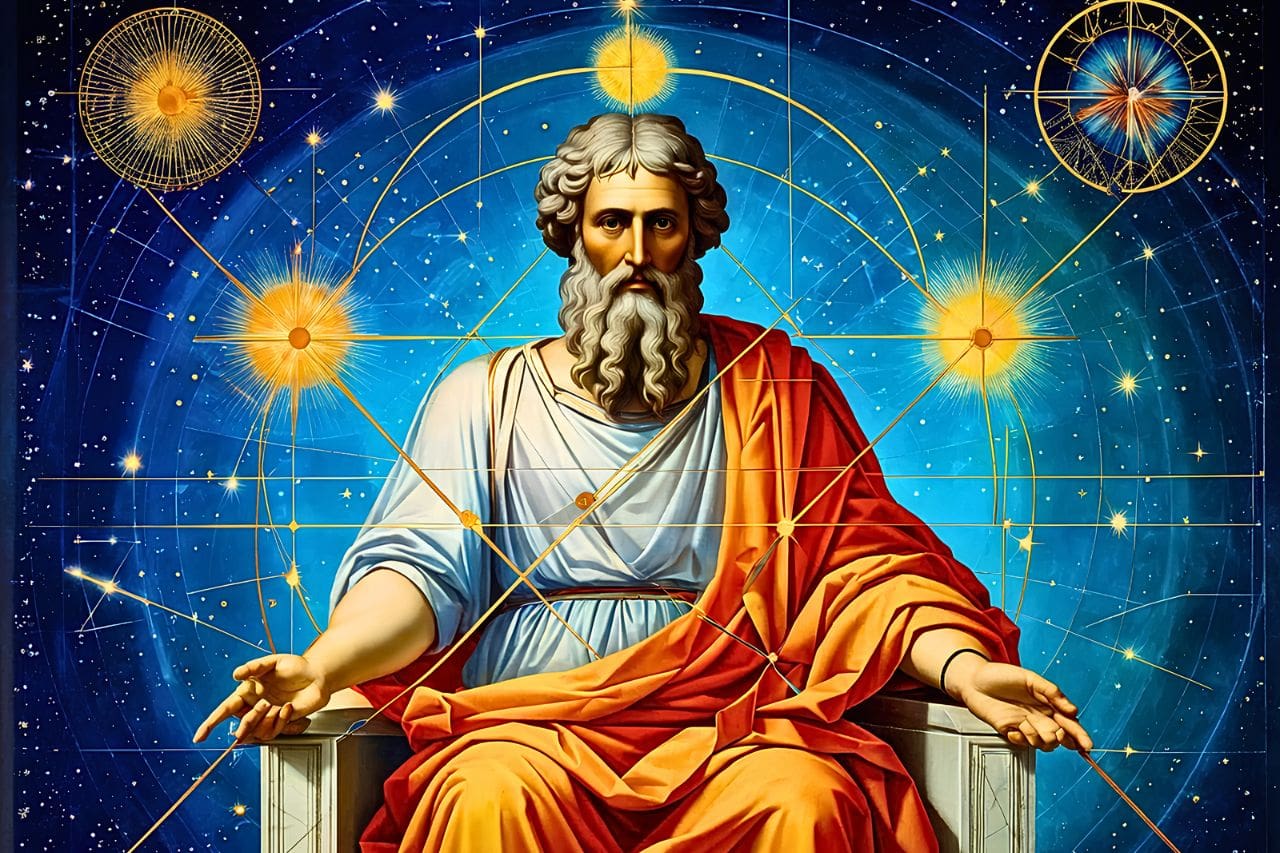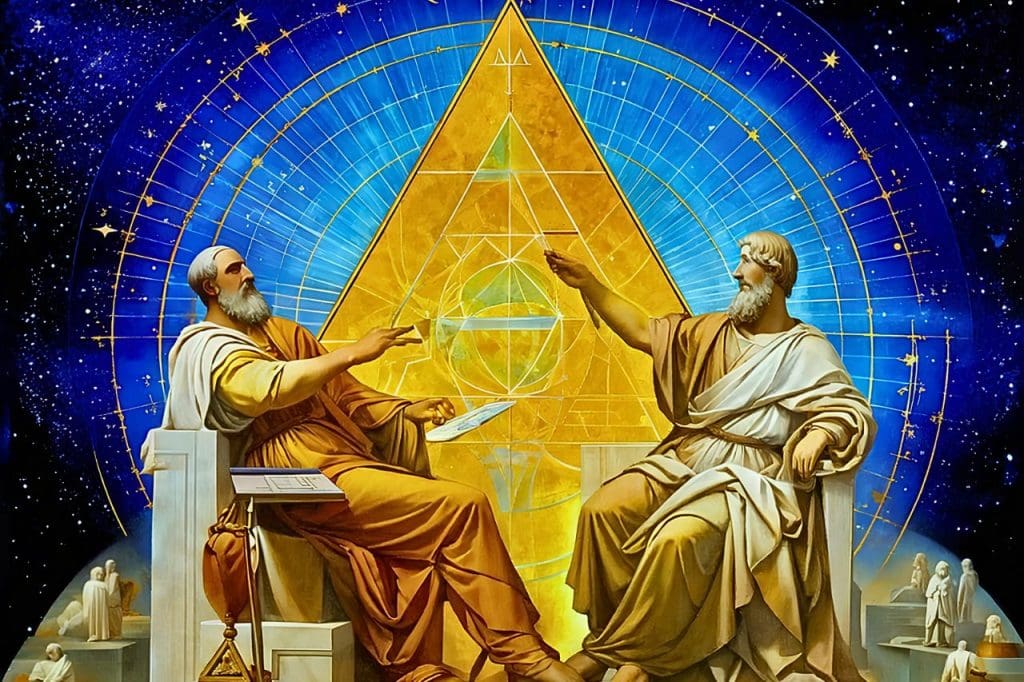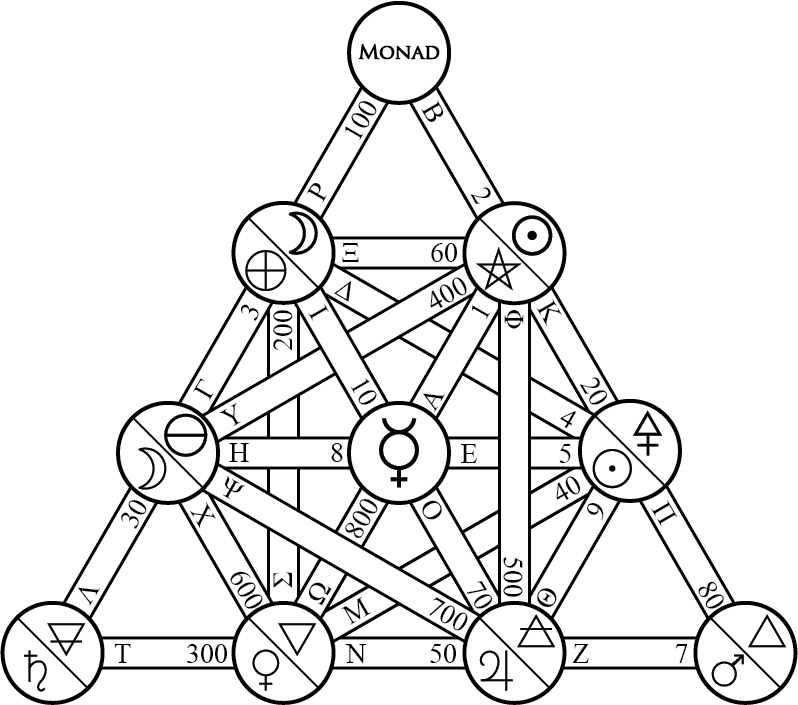

Hey there, goal-getters! Ever heard of Pythagoras? If you’re like most people, you probably associate him with a dusty math theorem from high school. But did you know this ancient Greek philosopher was onto something way bigger than triangles?
We often find ourselves caught in the whirlwind of modern life, chasing after fleeting pleasures and material possessions. But what if there’s a path to a more fulfilling existence, one that resonates with the timeless wisdom of ancient philosophy? Let’s delve into the fascinating world of Pythagorean metaphysics and spiritual principles and discover how we can apply them to enrich our daily lives.
The Pythagorean philosophy offers a treasure trove of practical wisdom that can transform your life—no geometry degree required. Ready to tap into the power of the ancients and level up your game? Let’s dive into the mind-blowing world of Pythagorean principles for everyday life and success.
At the heart of Pythagorean teachings lies the idea of harmonia – a state of balance and order that permeates the universe. This isn’t just about pleasing sounds, though. It’s a way of life that encompasses everything from your relationships to your personal goals.
Find Your Rhythm: Think of your life as a symphony. Are there any instruments out of tune? Are you trying to play too many notes at once? Focus on finding a sustainable pace that allows you to excel in all areas of your life without burning out.
Simplify and Declutter: Pythagoras believed in the power of minimalism. Clear your mind, your schedule, and your physical space of unnecessary distractions. This will free up your energy for the things that truly matter.

Section 2: The Power of Numbers
Pythagoras saw numbers as the building blocks of reality. He believed that each number held a unique vibration and meaning. While we’re not going to get bogged down in numerology here, there’s a simple takeaway: Pay attention to patterns and cycles in your life.
How to Apply It:
Track Your Progress: Use numbers to measure your goals and celebrate your wins. This can be as simple as noting how many words you write each day or how many miles you run each week.
Recognize Recurring Themes: Are there any patterns in your relationships or career choices? Are you constantly hitting the same roadblocks? By identifying these patterns, you can gain valuable insights and make more informed decisions.
Section 3: The Golden Ratio: Nature’s Secret Blueprint
The Pythagoreans were obsessed with the Golden Ratio – a mathematical proportion found throughout nature and art. It’s often associated with beauty and balance, and you can even find it in your own body (check out the proportions of your fingers and face!).
How to Apply It:
Design Your Life: Use the Golden Ratio to create aesthetically pleasing environments – both in your home and your digital spaces. A well-organized workspace can do wonders for your focus and creativity.
Seek Harmony in Relationships: The Golden Ratio reminds us to strive for balance in our interactions with others. This means giving and receiving, speaking and listening, and leading and following.
Section 4: The Importance of Community
The Pythagoreans lived in tight-knit communities that valued friendship, learning, and self-improvement. They understood the power of collaboration and the importance of surrounding yourself with positive influences.
How to Apply It:
Build Your Tribe: Cultivate relationships with people who inspire and support you. This could mean joining a mastermind group, finding a mentor, or simply spending more time with loved ones who lift you up.
Give Back: The Pythagoreans believed in the importance of sharing their knowledge and resources. Find ways to contribute to your community, whether it’s volunteering your time or sharing your expertise.
Have you ever paused to listen to the symphony of nature? The rustling leaves, the gentle lapping of waves, the chirping of birds—all these sounds blend together in a harmonious melody. Pythagoras believed that this harmony wasn’t just a coincidence; it was a reflection of the mathematical principles that govern the universe. He envisioned the celestial bodies moving in perfect harmony, creating a celestial music known as the “Music of the Spheres
Amidst the rustling leaves and dappled sunlight, there exists a silent conversation—one that transcends words and flows through the very fabric of existence. It’s the language of nature, whispered by the wind, sung by the birds, and echoed in the babbling brooks.
How to apply it:
When you step into the forest, you become part of this ancient dialogue. The trees share their wisdom, their roots intertwining like old friends. The moss-covered stones tell tales of time immemorial, etched with the memories of seasons past.
And what do we say in return? Perhaps it’s in the way we breathe—the deep inhalation of petrichor after rain, the exhale that releases our worries. Or maybe it’s the way we pause to admire a delicate wildflower, acknowledging its existence.
In the quietude of nature, we find solace. We unplug from the digital cacophony and tune in to the symphony of crickets, frogs, and distant waves. We learn patience from the unfolding petals of a blooming flower, resilience from the gnarled branches of an ancient oak.
So, let us converse with the rustle of leaves, the dance of fireflies, and the constellations above. Let us listen, not just with our ears, but with our hearts. For in this communion, we discover that we are not separate from nature—we are an integral part of its poetry
Your Turn to Channel Your Inner Pythagoras
Pythagoras wasn’t just a mathematician; he was a lifestyle guru way ahead of his time. By incorporating his timeless wisdom into your daily life, you can unlock your full potential and achieve a level of success you never thought possible. So go ahead, embrace the harmonia, find your rhythm, and unleash the power of the ancients!
One of the most revered symbols in Pythagorean philosophy is the Tetractys, a triangular arrangement of ten dots. The Tetractys represents the first four numbers (1, 2, 3, and 4), which add up to ten, a number considered sacred by the Pythagoreans. This symbol embodies the principles of unity, diversity, harmony, and perfection. It serves as a reminder that everything in the universe is interconnected and that we are part of a greater whole.
Let’s delve deeper into the mystical world of the Tetractys, a symbol that resonates with profound wisdom and cosmic significance.

In the quiet chambers of Pythagorean thought, the Tetractys stands as a luminous beacon—a geometric emblem that encapsulates both mathematical elegance and metaphysical insight. Picture it: a simple triangle composed of ten dots arranged in four rows. Each row contains a specific number of dots:
1. The Monad (1): At the apex of the Tetractys, we find the solitary dot—the Monad. It represents the primal source, the undivided unity from which all emanates. In this singularity, we glimpse the ineffable essence of existence.
2. The Dyad (2): Descending to the second row, we encounter two dots. The Dyad signifies duality, polarity, and the interplay of opposites. It embodies the tension between light and shadow, male and female, yin and yang. Here, the dance of existence begins.
3. The Triad (3): The third row unveils three dots, forming a perfect equilateral triangle. The Triad symbolizes harmony, balance, and creativity. It represents the trinity—the synthesis of thesis, antithesis, and synthesis. In this triadic dance, creation unfolds.
4. The Tetrad (4): Finally, the base of the Tetractys holds four dots, forming a square. The Tetrad embodies stability, materiality, and the four elements: earth, water, air, and fire. It is the foundation upon which the cosmos rests.
But why does the Tetractys hold such reverence? What secrets does it whisper to those who contemplate its arrangement?
1. Unity: The Monad, that singular dot, represents the divine unity—the ineffable One. From this unity, all multiplicity emerges. It reminds us that beneath the apparent diversity of existence, there exists an underlying oneness.
2. Diversity: The Dyad introduces duality—the dance of opposites. It acknowledges the dual nature of reality: light and darkness, expansion and contraction, life and death. Yet, even in this polarity, there exists a hidden harmony.
3. Harmony: The Triad weaves a harmonious tapestry. Three notes create a chord; three dimensions form space. It symbolizes the creative process—the birth of ideas, the interplay of forces, and the emergence of beauty.
4. Perfection: The Tetrad, with its fourfold symmetry, represents completion and perfection. It mirrors the four cardinal directions, the seasons, and the elements. It reminds us that the universe, in its intricate design, is whole and complete.
5. Nurture Your Soul (Yourself): You don’t have a soul. You ARE a soul. You are a soul inhabiting a phycial body while in this physical world.
The Pythagoreans believed that the soul is immortal and that it undergoes a cycle of reincarnation. They emphasized the importance of nurturing the soul through spiritual practices such as meditation, contemplation, and self-reflection. By tending to our spiritual well-being, we can find meaning and purpose in life.
6. Live in Accordance with Virtue:
Virtue, for the Pythagoreans, was not just a moral code; it was a way of life. They believed that by living in accordance with virtues such as honesty, integrity, courage, and compassion, we could achieve inner peace and happiness. Striving to embody these virtues in our daily lives can lead to personal growth and transformation.
And what of us, dear seeker? We, too, are part of this cosmic geometry. The Tetractys whispers that we are not isolated beings but interconnected threads in the fabric of existence. Our thoughts ripple through the universal matrix; our actions resonate across the celestial loom.
So, when you gaze upon the Tetractys, remember: you are both the Monad and the Tetrad, the unity and the diversity. You carry within you the sacred proportions—the music of the spheres. And as you trace the dots with your mind’s eye, know that you are woven into the grand tapestry of life, contributing your unique note to the cosmic symphony. 🌌🔮✨
FAQs About Pythagorean Principles
Q: Are the Pythagorean principles religious?
A: Not necessarily. While Pythagoras and his followers had spiritual beliefs, the core principles can be applied to any worldview or belief system.
Q: Do I need to be a math whiz to understand and apply these principles?
A: Absolutely not! The beauty of Pythagorean philosophy is that it offers practical wisdom that anyone can use to improve their life.
P.S. Have you found any other ways to apply Pythagorean principles to your life? Share your insights in the comments below! We’d love to hear from you.
Happy Living!
selfstalker.com

Monday - Thursday 7 AM - 5 PM PST
admin@selfstalker.com support@selfstalker.com